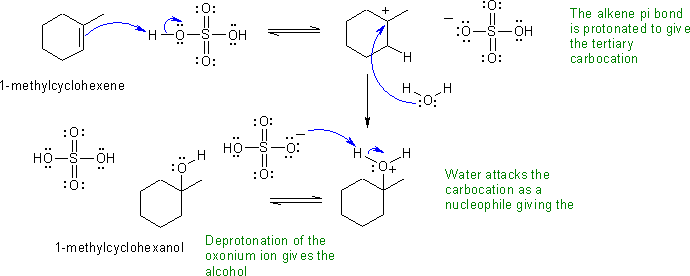
The following diagram shows the solution to the
mechanistic question. Note that all the information applies to a single
reaction sequence that has been completely described verbally.
There is no need for extra reagents or
extra steps etc. The curly arrows are drawn specifically to match the
text in the question. The biggest problem students have is making sure they
understand the language of chemistry. Most students have trouble because they
can't draw the structures from the IUPAC names (that means they don't know their
nomenclature well enough). Read the words carefully, and then make the curly
arrows tell that same story. There is NO need for extra steps. Remember
curly arrows go from electron rich to poor and to balance the
formal charges at each step - errors on formal charges were common.
a.

If you struggled with this part of the question, first draw the compounds whose names were provided, then think about the types of reactions (e.g. acid / base) and try to fill in the structures in the gaps, then finally add the required curly arrows to account for all the bonding changes.
b. The alkene reacts with the acid to give the same tertiary carbocation. But since there is no water present, a different nucleophile, the chloride ion, reacts to give 1-chloro-1-methylcyclohexane. This part of the question is about recognising the nucleophile.

c. Why is aqueous hydrochloric acid a poor choice? If you look at the answers to parts a and b, you see that the difference is due to the nucleophile. Hence aq. HCl could form two products, the alcohol from a and the alkyl chloride from b since both water and chloride would be present. Note that under aqueous conditions, it is H3O+ that is the acid present for either aq. H2SO4 or aq. HCl.
d. Compare to the reaction in part a which states that it gives the more stable carbocation. Look at the 1-phenylpropene and consider the two possible carbocations...by applying the principles of resonance, we can predict that the one carbocation is benzylic. Hence the major product is 1-phenyl-1-propanol. From the hydrocarbon laboratory experiment, you should remember that aromatic rings are less reactive than the alkene so it's the alkene that reacts.

Common errors:
a.
b. Anhydrous means no water. Therefore the chloride ion acts as the nucleophile and reacts with the same carbocation.... the question is about being able to recognise an alternate electron donor, a nucleophile.
c. A lot of confusion about which is the stronger acid H2SO4 or HCl and which is the stronger base, HSO4- or Cl-.
d. Couldn't draw the starting material. Did not think about how resonance would stabilise the carbocation.